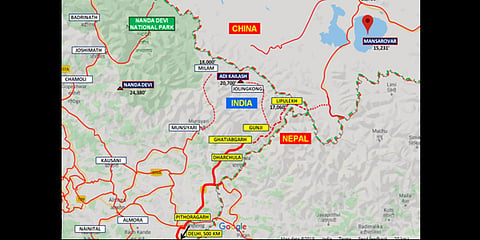

NEW DELHI: Good news came for Kailash Mansarovar pilgrims on Friday as a new road was inaugurated which will make the trip more comfortable and less expensive to visit the holy abode of Lord Shiva which is located in Tibet Autonomous Region under China.
Defence Minister Rajnath Singh inaugurated the Link Road to Kailash Mansarovar via Video Conference. "Border Roads Organisation connects Kailash Mansarovar Route to China Border. While combating Covid-19 pandemic, BRO in Uttarakhand has connected Kailash Mansarovar route to Lipulekh pass at a height of 17,060 ft; thus providing connectivity to border villages and security forces," Singh tweeted.
This is an old route but was precarious due to its altitude and terrain. With the new road, a light vehicle can ply up to 75 kms (5 km short of boundary) and a five day trek will be reduced to two days of road travel thus saving six days of to and fro journey.
Also apart from saving time, there will be several advantages. The new route is the shortest, only one-fifth of the distance of road travel as compared to other routes. The majority of the distance on new route will also be on Indian side.
There is no air travel involved and the complete route is involved on vehicles, except for a 5 km trek on China side across Lipulekh Pass. Despite a requirement of acclimatisation, even the elderly can also undertake the yatra now and in case of any natural calamity during Yatra, the option to evacuate by helicopter is available.
The new route involves travelling by road to Pithoragarh (490 km from Delhi), thereafter 130 km of road travel and 79 km or five days of foot trek from Ghatiabgarh to Lipulekh Pass on boundary with China. Across the International Border, there is a further trek of 5 km on Chinese side followed by a road journey of 97 km and 43 km of foot parikrama.
At present, there are two more routes available to undertake the Kailash Mansarovar Yatra. One is via Sikkim and other via Kathmandu. The Sikkim route involves taking a flight to Bagdogra (1115 km form Delhi), thereafter 1665 km of road travel and 43 km of parikrama on foot. Out of 1665 km, only 175 km travel is in India.
The other route involves taking a flight to Kathmandu (1150 km from Delhi) and thereafter a combination of two flights with road travel (1940 km) or two flights & one helicopter sortie (755 km) or a total road travel from Nepal (840 km). The distance excludes 43 km of foot to Parikarma in China.
Kailash Parbat is located in vicinity of Mansarovar Lake which is less than 100 km from Uttarakhand border. Mount Kailash is considered sacred in four religions: Hinduism, Buddhism, Jainism and Bon.
For Hindus, Mt Kailash is traditionally recognised as abode of God Shiva and it is considered the holy centre of the planet and a manifestation of heaven. The holy water of Lake Mansarovar is said to have the power of washing away our sins thus it is believed that circumambulating Mount Kailash can expunge wrongdoings.
The Border Roads Organisation carried out Kailash Mansarovar Road construction activity even while country was under lockdown due to COVID-19 pandemic. The BRO followed all protocol.
The new road alignment is along the Kali River which is the boundary between India and Nepal. The end point of the road is at Lipulekh Pass with China which is near the tri-junction of India, China and Nepal.
In this sector, Special Task Force (STF) Hirak of BRO is constructing and maintaining roads ahead of Pithoragarh which is 490 km from Delhi. The road from Pitharogarh to Tawaghat is a 107.6 km long existing double lane road is under maintenance by BRO.
From Tawaghat to Ghatiabgarh the stretch is 19.5 km long and existing single lane road under development to double lane road by BRO. The construction is expected to end by March 2021. The Road from Ghatiabgarh to Lipulekh is 80 km long new road (greenfield) under construction by BRO with a deadline of December 2022.
The road was approved in 2005 at a cost of Rs 80.76 crores and was revised in 2018 with a revised cost of Rs 439.40 crores and is expected to be completed by December 2022.
Due to the high altitude terrain, steep mountains having hard rock content, extreme temperatures, limited working season, numerous flash floods and cloud bursts as well as frequent landslides; the progress was slow. Inducting equipment to create multiple attack points was also a challenge.
The work speed picked up in last two years due to preponderance of construction equipment (90 equipments were deployed on the road) as well as increasing attack points to fourteen (from earlier three). New attack points were made by paving jungle lanes and fording through the Kali River.